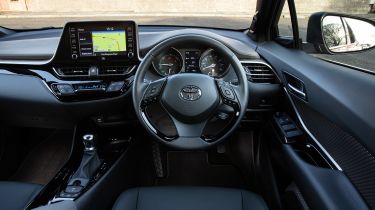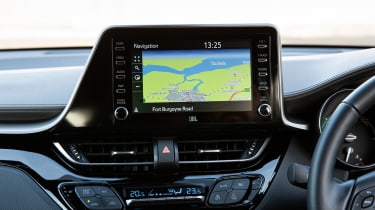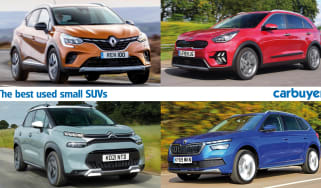Toyota C-HR SUV - Interior & comfort (2016-2023)
Toyota C-HR features the brand’s best interior for ages and shakes off its frumpy reputation
Somehow, the Toyota C-HR’s unexpectedly accomplished handling manages to coexist with ride quality that puts some rivals to shame. Although the biggest or most sudden road bumps do make their way through to disturb occupants, poor road surfaces are generally shrugged off. There’s not a huge amount of noise from the tyres, either, although you can hear the wind rustling around the front roof pillars at motorway speeds with the stereo turned down. Generally, C-HR occupants will find the car quiet and smooth to travel in.
Toyota C-HR dashboard
After pausing to take in the details of the Toyota C-HR’s adventurously designed exterior, climbing aboard will quickly confirm the Japanese brand has worked equally hard on the interior, using well chosen shapes and textures for a modern, funky look. Most impressive, though, is how it feels – with touch points in soft plastics as well as gloss finishes and a lack of creaks when you apply pressure to the trim all adding up to an upmarket atmosphere.
The first thing you notice is that the front-seat environment is several steps beyond the dowdy dashboards found in Toyotas of old. It wraps around to remind you that this is a car with the driver’s interests at heart, with controls laid out in an intuitive, clear order. Depending on trim level, the dashboard contains contrasting inserts – in grey on Icon, silver with Excel or a classy blue on Dynamic models.
Equipment
All C-HRs produced after the facelift in 2019 are particularly well equipped, with climate and cruise control, automatic windscreen wipers, a reversing camera, DAB radio and LED headlights. There’s an auto-dimming rear-view mirror and Toyota’s excellent Touch 2 infotainment system with an eight-inch touchscreen. It now provides Apple CarPlay and Android Auto as standard. Step up from Icon to Design trim for sat nav and keyless go, 18-inch wheels, Park Assist, front and rear parking sensors and voice recognition. The Excel adds Rear Cross Traffic Alert, Blind Spot Monitor with Lane Change Assist, heated black leather seats and steering wheel, LED adaptive headlights with sequential indicators and LED tail lights. The Dynamic brings a two-tone roof/body combination, while the top-spec Orange Edition features 18-inch matt black alloys, a black bi-tone roof with a unique orange body colour, as well as a JBL Premium audio system with nine speakers.
Options
Within reason, you can order the C-HR with any option you like. Toyota offers 20 different accessory packs and around 200 individual items, from side steps to iPad systems and roof racks to DVD players for keeping rear passengers entertained.
Technology
The C-HR uses Toyota’s Touch 2 infotainment system, which is one of the most intuitive in the industry. It’s mounted high up on the dashboard to ensure its seven-inch touchscreen can be seen and reached easily. Standard on all models, even on the entry-level Icon, it integrates DAB radio, Bluetooth and Apple CarPlay and Android Auto.
A ‘Go’ upgrade is featured on Excel and Dynamic models. This includes sat-nav and online connectivity. Entering a navigation route is straightforward, although the lack of tablet-style ‘pinch and swipe’ recognition makes zooming in a little awkward.
Which Is Best?
Cheapest
- Name1.8 Hybrid Icon 5dr CVT
- Gearbox typeAuto
- RRP£31,440
Most Economical
- Name2.0 PHEV Design 5dr CVT
- Gearbox typeAuto
- RRP£39,230
Fastest
- Name2.0 PHEV Design 5dr CVT [Bi-tone]
- Gearbox typeAuto
- RRP£39,580














